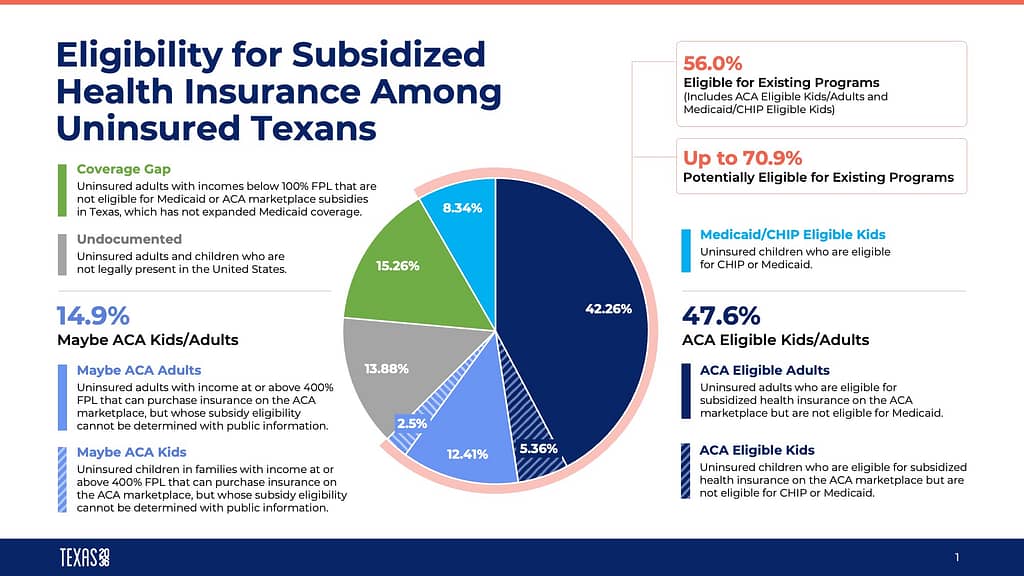Texas crosses threshold of 3 million covered by ACA
Texas enrollment in health plans offered through the Affordable Care Act’s Health Insurance Marketplace has surpassed 3 million for the first time, meaning that more than 10% of the state’s population now has coverage through the federal health exchange.
The federal government today released its first look at state-level data for the current open enrollment period, which began Nov. 1. The Texas enrollment figure of 3.3 million reflects plan selections through Dec. 23.
The open enrollment period runs through Jan. 16 for plans that begin coverage Feb. 1.
As the graphic below shows, ACA enrollment in Texas has increased dramatically since 2020. The partial enrollment figures for the 2024 Open Enrollment Period shows that ACA enrollment is up an astounding 36.5% over the final enrollment figures for 2023. That’s an even larger percentage increase than between 2022 and 2023 when Texas plan selections increased 31%, the greatest increase of any state.

In 2021, Texas lawmakers passed legislation that instituted a “focused rate review” aimed at better aligning health insurance premiums across the different tiers of coverage in the Health Insurance Marketplace.
“This bipartisan, unanimously supported legislation helped make certain insurance plans much more affordable for many Texans.” said Texas 2036 Senior Policy Advisor Charles Miller. “Importantly, it showed that the Texas Legislature is interested in and can work together on innovative solutions to our persistently high uninsured rate.”
Texas could further improve uptake in ACA health plans if it decides to build and operate a state exchange on which ACA marketplace plans would be sold.
As of 2024, 18 states — including Kentucky, Idaho and Pennsylvania — have chosen to operate their own state exchange, enrolling nearly 4.2 million Americans.
Operating a state-based marketplace could allow Texas to streamline the enrollment process to make it less cumbersome for the uninsured, create opportunities to improve outreach to the uninsured and rebrand the exchange as a Texas product as a way of addressing fears or negative perceptions about enrolling in the ACA.
“Some approaches to reducing Texas’ uninsured rate only become possible if Texas builds and operates a state exchange,” said Miller. “Creating a state exchange would not only provide administrative flexibility for Texas to implement tailored solutions, but it would also provide a revenue stream to pay for such policies and efforts.”
Texas 2036 estimates that between 2.7 and 3.5 million Texans are eligible for free or subsidized health coverage through existing ACA subsidies, Medicaid or the Children’s Health Insurance Program (CHIP). Nearly 1.5 million appear to be eligible for subsidies through the ACA large enough to cover the full premium cost of at least one plan, while another 400,000 children appear to be eligible for Medicaid or CHIP.

The number of uninsured Texans has been a persistent challenge to the state. Today, the number of Texas residents lacking health insurance is nearly 5 million, representing more than 16% of the total population. While this percentage is lower than it has been in recent years, it remains the largest percentage of any state and more than double the national average.
As part of a long-term effort to address this crisis, Texas 2036 conducted a multi-year study to identify systemic, behavioral and psychological obstacles to Texans gaining affordable coverage.
Key findings of the report include that Medicaid expansion alone – while a fiscally efficient solution for the state to reduce the uninsured rate – won’t solve Texas’ uninsured crisis by itself as many uninsured Texans have middle-class incomes, and nearly twice as many uninsured Texans are currently eligible for a free ACA plan as are in the coverage gap.
“Our previous analysis of the potential impact of Medicaid expansion in Texas exposed the problem as being larger than any one-size-fits-all solution,” Miller said. “We decided to listen to the people we’re trying to help, to hear the barriers they perceived. That process allowed us to see that many uninsured Texans could be helped by making existing programs work more efficiently and effectively.”
The study suggests that Texas policymakers could make significant inroads toward reducing the state’s uninsured population by increasing awareness of the availability of affordable health coverage options, reducing bureaucratic and administrative complexity during the enrollment process, and improving the customer experience for Texans seeking out coverage.
To download the full report, visit www.texas2036.org/uninsured
